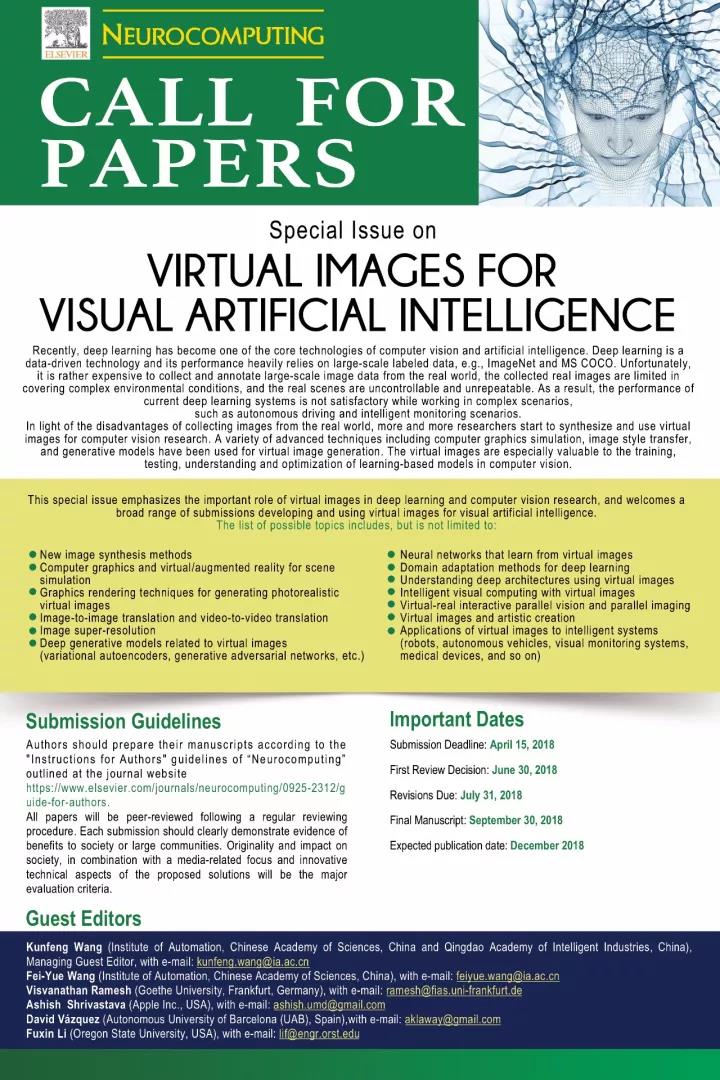博文
CFP | Virtual Images for Visual Artificial Intelligence
|

CALL FOR PAPERS
Special Issue on Virtual Images for Visual Artificial Intelligence
Summary and Scope
Recently, deep learning has become one of the core technologies of computer vision and artificial intelligence. Deep learning is a data-driven technology and its performance heavily relies on large-scale labeled data, e.g., ImageNet and MS COCO. Unfortunately, it is rather expensive to collect and annotate large-scale image data from the real world, the collected real images are limited in covering complex environmental conditions, and the real scenes are uncontrollable and unrepeatable. As a result, the performance of current deep learning systems is not satisfactory while working in complex scenarios, such as autonomous driving and intelligent monitoring scenarios.
In light of the disadvantages of collecting images from the real world, more and more researchers start to synthesize and use virtual images for computer vision research. A variety of advanced techniques including computer graphics simulation, image style transfer, and generative models have been used for virtual image generation*. The virtual images are especially valuable to the training, testing, understanding and optimization of learning-based models in computer vision**.
This special issue emphasizes the important role of virtual images in deep learning and computer vision research, and welcomes a broad range of submissions developing and using virtual images for visual artificial intelligence. The list of possible topics includes, but is not limited to:
● New image synthesis methods
● Computer graphics and virtual/augmented reality for scene simulation
● Graphics rendering techniques for generating photorealistic virtual images
● Image-to-image translation and video-to-video translation
● Image super-resolution
● Deep generative models related to virtual images (variational autoencoders, generative adversarial networks, etc.)
● Neural networks that learn from virtual images
● Domain adaptation methods for deep learning
● Understanding deep architectures using virtual images
● Intelligent visual computing with virtual images
● Virtual-real interactive parallel vision and parallel imaging
● Virtual images and artistic creation
● Applications of virtual images to intelligent systems (robots, autonomous vehicles, visual monitoring systems, medical devices, and so on)
Submission Guidelines
Authors should prepare their manuscripts according to the "Instructions for Authors" guidelines of “Neurocomputing” outlined at the journal website
https://www.elsevier.com/journals/neurocomputing/0925-2312/guide-for-authors.
All papers will be peer-reviewed following a regular reviewing procedure. Each submission should clearly demonstrate evidence of benefits to society or large communities. Originality and impact on society, in combination with a media-related focus and innovative technical aspects of the proposed solutions will be the major evaluation criteria.
* Kunfeng Wang, Chao Gou, and Fei-Yue Wang. Parallel vision: an ACP-based approach to intelligent vision computing. Acta Automatica Sinica, 2016, 42(10): 1490−1500.
** Kunfeng Wang, Chao Gou, Nanning Zheng, James M. Rehg, and Fei-Yue Wang. Parallel vision for perception and understanding of complex scenes: methods, framework, and perspectives. Artificial Intelligence Review, 2017, 48(3): 299−329.
Important Dates
Submission Deadline: April 15, 2018
First Review Decision: June 30, 2018
Revisions Due: July 31, 2018
Final Manuscript: September 30, 2018
Expected publication date: December 2018
Guest Editors
Kunfeng Wang
Institute of Automation, Chinese Academy of Sciences, China and Qingdao Academy of Intelligent Industries, China
Managing Guest Editor
E-mail: kunfeng.wang@ia.ac.cn
Fei-Yue Wang
Institute of Automation, Chinese Academy of Sciences, China
E-mail: feiyue.wang@ia.ac.cn
Visvanathan Ramesh
Goethe University, Frankfurt, Germany
E-mail: ramesh@fias.uni-frankfurt.de
Ashish Shrivastava
Apple Inc., USA
E-mail: ashish.umd@gmail.com
David Vázquez
Autonomous University of Barcelona (UAB), Spain
E-mail: aklaway@gmail.com
Fuxin Li
Oregon State University, USA
E-mail: lif@engr.orst.edu
https://blog.sciencenet.cn/blog-2374-1088411.html
上一篇:ITSM CFP | 王飞跃:智能交通系统驶向第三轴心时代
下一篇:换道超车:第三轴心时代的智能产业与智慧社会